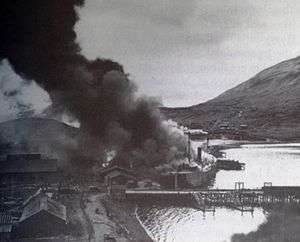SS Northwestern (1889)
The SS Northwestern, originally SS Oriziba, was a passenger and freight steamship launched in 1889 by the Delaware River Iron Ship Building and Engine Works, Chester, Pennsylvania which spent most of its career in service in the waters of the Territory of Alaska.[2] The ship from early in its career had a reputation for trouble, and was frequently involved in groundings, collisions with other ships, and with port facilities. She first served as a transport in the West Indies as Oriziba, and was acquired by the Northwestern Steamship Company in 1906, sailed around Cape Horn, and renamed Northwestern. For the next thirty years she worked along the Alaska coast, transporting people, mail, and goods, as well as ore from mining operations at Kennecott.[3]
 SS Northwestern in flames at Dutch Harbor, Unalaska, Alaska | |
| History | |
|---|---|
| United States | |
| Name: | Northwestern |
| Namesake: | The Northwestern Steamship Company |
| Builder: | Delaware River Iron Ship Building and Engine Works |
| Launched: | 23 November 1889 |
| Fate: | Sank at mooring, Captains Bay, Unalaska Island |
| Status: | Hulk visible projecting from bay |
| General characteristics | |
| Class and type: | Passenger and freight transport |
| Length: | 336 ft (102 m) |
| Speed: | 14 knots (26 km/h; 16 mph) |
S. S. Northwestern Shipwreck Site | |
_-_NARA_-_297819.jpg) Postcard image of the Northwestern covered in ice after a storm | |
 | |
| Location | Port Levashef, at the head of Captains Bay |
| Nearest city | Unalaska |
| Coordinates | 53°49′50″N 166°36′37″W |
| NRHP reference No. | 94001065[1] |
| Added to NRHP | 12 September 1994[1] |
On 14 February 1909, Northwestern sighted a flare from the sloop Nugget, which had been blown out into the Gulf of Alaska off Cross Sound by a storm on 9 February during a voyage from Lituya Bay to Juneau, Alaska, and whose crew was abandoning her 75 nautical miles (139 km; 86 mi) off Cape Fairweather (58°48′30″N 137°56′45″W) after a second storm struck and destroyed her sails and rigging. Northwestern rescued seven crewmen from Nugget and transported them to Juneau.[4]
On 25 July 1933, Northwestern ran aground off Alaska's Sentinel Island Lighthouse and subsequently was beached on the Eagle River Sand Spit. Her passengers were taken off by a United States Government steamship.[5]
Northwestern was pressed into service by the United States Navy during World War II, and was serving as housing for workers at Dutch Harbor on Unalaska when the area was bombed by the Japanese in June 1942. On 4 June a bomb struck her, inflicting extensive damage. Her hulk afterward was loaded with scrap and towed to Captains Bay in anticipation of eventually being towed to Seattle, Washington. Despite U.S. Navy records indicating that she was towed to Seattle, she in fact remained in Captains Bay, and eventually sank around 1946; there are differing accounts as to the circumstances of the sinking. Approximately 50 feet (15 m) of her hull is normally visible at the head of Captains Bay.[3]
The site of the shipwreck was listed on the National Register of Historic Places in 1994.[1]
References
- "National Register Information System". National Register of Historic Places. National Park Service. July 9, 2010.
- Burwell, Michael (2014). The S.S. Northwestern: Sailing Sheltered Seas, an Illustrated History. Anchorage, AK: United States Department of the Interior, National Park Service. Retrieved 3 February 2018.
- Chandonnet, Fern (ed) (2007). Alaska at War, 1941-1945: The Forgotten War Remembered. University of Alaska Press. pp. 219ff. ISBN 9781602231351.CS1 maint: extra text: authors list (link)
- alaskashipwreck.com Alaska Shipwrecks (N)
- "American steamer beached". The Times (46507). London. 27 July 1933. col A, p. 23.
See also
| Wikimedia Commons has media related to Northwestern (ship, 1889). |